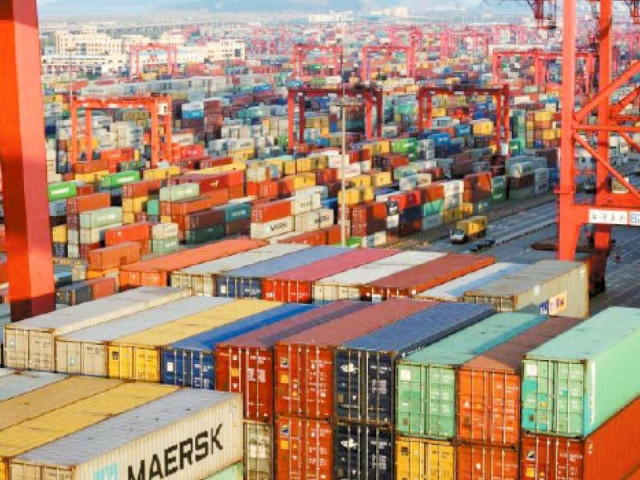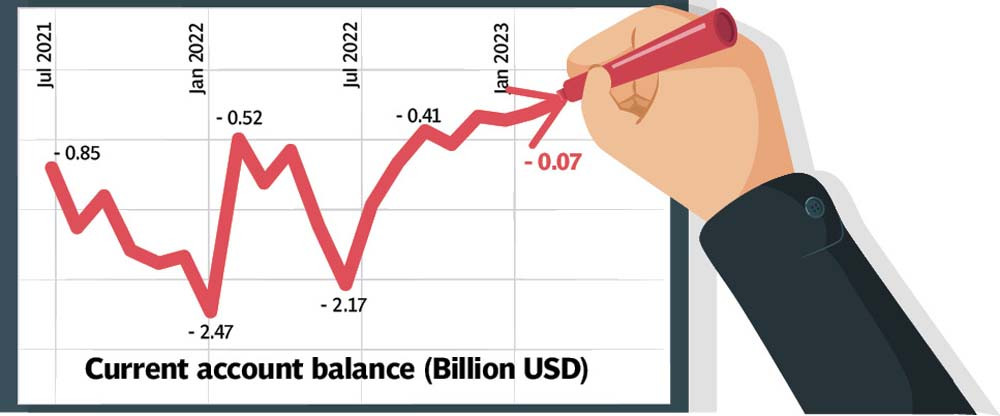CAD drops to $74m in Feb
Controlled imports improved CAD but slowed economic activities to a near halt, rendering millions of people jobless

Pakistan’s current account deficit (CAD) – the gap between the country’s higher foreign expenditures and low income – hit a two-year low at $74 million, missing the market’s expectation of turning the deficit into a surplus this February.
The State Bank of Pakistan (SBP) reported on Monday that the deficit (CAD) dropped by 86% to $74 million in February compared to $519 million in the same month of the previous year. This was 68% lower than the $230 million recorded in January 2023.
This improvement in the CAD was achieved by limiting imports – to manage with low foreign exchange reserves – and mitigate the high risk of default on foreign debt repayments. The low imports, however, have slow economic activities to a near halt and rendered millions of people jobless in the ongoing fiscal year 2023.
The government is making an effort to revive the stalled International Monetary Fund (IMF) loan programme to unlock foreign financing worth multibillion dollars and reopen its economy.
Cumulatively in the first eight months (July-February) of FY23, CAD has declined by 68% to $3.9 billion compared to $12.1 billion in the same period last year, according to the central bank. Speaking to The Express Tribune, Ismail Iqbal Securities Head of Research Fahad Rauf said, “The CAD is no longer a problem anymore. It is under control.”
At the same time, he said, “However, we cannot celebrate it (improved CAD), as it has been achieved by administrative controls and not by increasing export earnings or improving the inflows of workers’ remittances sent home by overseas Pakistanis.”
“A large number of factories have shut down either partially or completely due to the non-availability of imported raw material and millions of people have lost their jobs after the government took the much-delayed measures to fix CAD and improve the balance of foreign payments,” he said.
“The government should have taken preventative measures at the end of previous fiscal year and beginning of current fiscal year when the CAD was being recorded at $2 billion a month and the country had notable foreign exchange reserves,” observed Rauf.
Arif Habib Limited (AHL) reported that the primary reason behind the decline in CAD was a 24% drop in total imports in February compared to the same month of the last year. Total exports and workers’ remittances, however, decreased by 19% and 9%, respectively, in the month compared to the same month of the previous year.
“The deficit will continue to remain nominal or may turn into a slight surplus in each of the four remaining months (March-June) of FY23, predicted the analyst. His estimate suggests that the full-year CAD will be in the range of $2-3 billion in FY23.
Currently, Pakistan’s foreign exchange reserves stand at an estimated $4.8 billion after China provided $500 million under a rollover scheme last week.

design: Ibrahim Yahya
The reserves, however, are barely enough to provide one-month of import cover. In the meanwhile, the country is scheduled to repay foreign debt worth $7 billion in the last four months of FY23.
SBP Governor Jameel Ahmad said the other day that the country is to repay only $3 billion in foreign debt in the remaining months of FY23, while the remaining $4 billion will be rolled over. Like many other analysts, Rauf too was of the view that Pakistan is in dire need of the IMF’s $6.5 billion loan programme. “To avoid a symbolic default, as signs of default have already appeared in the domestic economy in the shape of fast rupee depreciation, high inflation and high key policy rates – we need the IMF loan to be revived quickly,” he said.
“Pakistan’s senior officials should play their due role in convincing friendly countries to issue financial commitments of $6-7 billion, which is the last pre-requisite required for the revival of the loan programme,” he remarked.
FDI inflows
Foreign direct investment (FDI) net inflows, into different sectors of the economy, settled at $101 million in February, compared to $91 million in the same month of the last year – showing an improvement of 11% on a year-on-year basis.
Cumulatively in the first eight months of FY23, the net FDIs inflows dropped by 40% to $784 million compared to $1.32 billion in the same period last year.
China made the single largest investment of $223 million that comes to about 28% of the total inflows in the eight months, followed by Japan at around $13 million (17% of total) and Switzerland with an investment of $123 million (16%), according to an AHL report.
As a whole, power, financial business and oil and gas exploration firms remained the top three recipients of the foreign investment.
Published in The Express Tribune, March 21st, 2023.
Like Business on Facebook, follow @TribuneBiz on Twitter to stay informed and join in the st conversation.



















COMMENTS
Comments are moderated and generally will be posted if they are on-topic and not abusive.
For more information, please see our Comments FAQ